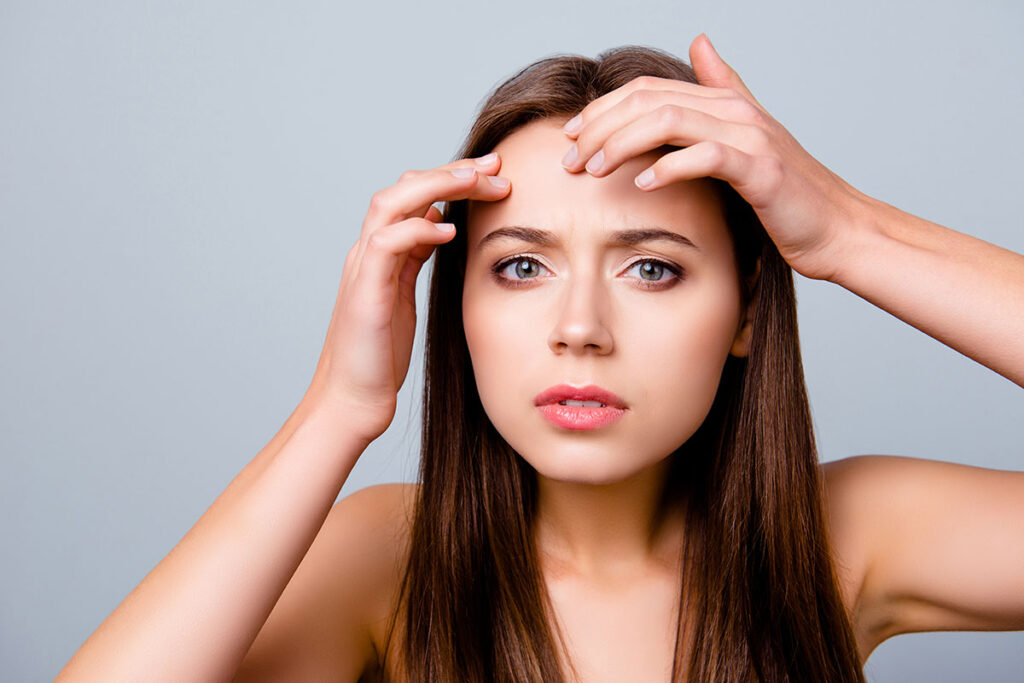Pimples, blemishes, zits — whatever you call them, acne isn’t the most fun thing to deal with. One of the factors that can make acne such a challenging skin issue is that there are many different types of acne out there. Some acne types respond to certain treatments while others don’t. Some forms of acne can be cleared up at home, while others might require the attention of a medical professional.
When you look in the mirror and see a spot on your skin, here’s how to identify what type of acne it is and a few tips on what you can do about each type of blemish.
Acne Vulgaris
Acne Vulgaris is a common skin condition that is often referred to as the most common type of acne. It is characterized by the presence of different types of pimples, such as whiteheads, blackheads, papules, and pustules. This condition is often caused by factors such as hormonal changes, genetics, and excessive oil production in the skin. It can be identified by its tendency to occur on the face, neck, chest, and back.
Treatment options for this common condition include using topical retinoids and maintaining a skincare routine that includes gentle cleansing for oily or dry skin types. Effective treatment can help manage symptoms and prevent future breakouts.

Whiteheads
Whiteheads are also known as closed comedones, which are small white bumps that form when hair follicles become clogged with dead cells (skin) and oil. They are commonly seen in cases of comedonal acne, usually appearing on the face, neck, chest, and back. To identify whiteheads, look for these white bumps on the skin’s surface.
Treatments for whiteheads often include using over-the-counter facial cleansers containing active ingredients like Salicylic Acid to unclog pores and prevent further breakouts. Regular cleansing can help to remove excess oil and dead skin cells from the affected area. Whiteheads are typically associated with mild acne caused by an overproduction of sebum by the skin’s sebaceous glands.
Blackheads
Blackheads are mild acne lesions caused by clogged pores, specifically clogged hair follicles. They appear as small black or dark-colored bumps on the skin’s surface. Unlike whiteheads, blackheads have open pores, allowing the trapped oil and dead skin cells to oxidize and turn dark in color.
To treat blackheads, individuals can use over-the-counter medications such as facial cleansers containing ingredients like Salicylic Acid or Benzoyl Peroxide to unclog pores and reduce inflammation. Additionally, using pore strips or nose strips can help temporarily remove blackheads. Consistent skin care routines that include gentle cleansing and exfoliation can also prevent the formation of new blackheads.
Papules
Papules are a type of inflammatory acne characterized by small, red bumps on the skin’s surface. These deep papules can be painful and cause discomfort. To identify papules, look for raised, inflamed bumps that are typically red in color. When treating papules, it is essential to use gentle skincare products such as mild facial cleansers and lotions to avoid further irritation.
Topical treatments containing ingredients like benzoyl peroxide can help dry out and clear up the blemishes effectively. It is important to maintain a consistent skincare routine to prevent the formation of new papules.
Pustules
Pustules are a form of moderate acne characterized by inflamed pimples with a white center surrounded by redness. The presence of pus in the center indicates inflammation and infection within the acne blemish. It is important not to pick or squeeze pustules as this can worsen inflammation, cause scarring, or spread the condition.
For occasional pustules, spot treatments containing ingredients like benzoyl peroxide may be effective. However, if you consistently experience multiple pustules, it is recommended to consult a medical professional for appropriate treatment options tailored to your specific skin condition and needs.
Nodules
Nodules are more severe and are characterized by large, painful bumps deep within the skin. They often feel firm and can cause discomfort when touched. Nodular acne is more difficult to treat than other types of pimples, and it usually requires professional medical intervention.
To treat nodules, dermatologists may prescribe oral medications such as isotretinoin or corticosteroids to reduce inflammation and prevent scarring. In some cases, drainage or corticosteroid injections may be necessary to alleviate pain and promote healing from nodules. It’s important to avoid picking or squeezing nodules, as this can worsen inflammation and lead to dark spots or scarring on the skin.
Cystic Acne
Cysts are a severe form of acne that presents as large, pus-filled bumps resembling boils. Cystic acne is painful and has a higher likelihood of leaving scars compared to other types of acne. To identify cysts, look for deep, inflamed lesions with a visible white or yellow center.
Treatment options for acne cysts may include prescription medications like azelaic acid to reduce inflammation and kill bacteria, chemical peels to exfoliate dead skin cells and unclog pores, to dry up excess sebum, or acne laser treatments to target any residual acne scars. It is crucial to seek professional help for severe acne cysts to prevent scarring and achieve clearer skin.
Trusting The Right Professional
Acne doesn’t have to interfere with your life or bring down your self-confidence. If you are concerned about pimples, Dr. Paul Vitenas and the staff at Mirror Mirror Beauty Boutique in Houston, Texas, can help. Call 281-810-9083 to schedule an appointment and learn more about your acne treatment plan options today.